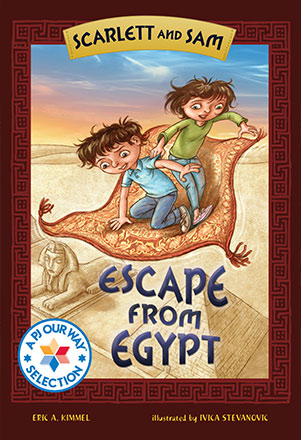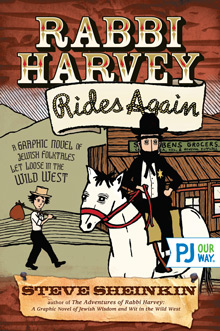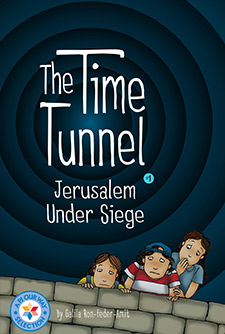Scarlett and Sam: Escape from Egypt
One minute Scarlett and Sam are arguing about the family seder, and the next they’re on a magic carpet, going back in time to when the Jews were slaves in Egypt! Can they help Moses, and will they ever get back home?
Average Rating
( hint: Login to leave a review! )
141 Reviews
Leave Review
What the Book is About
Jewish Content & Values
Positive Role Models
Content Advisory
Talk it Over!
More for You
What the Book is About
When twins Scarlett and Sam argue over who will ask the Four Questions at the seder, their grandmother explains that the story of the Exodus connects the Jewish people through the centuries, the way her old Persian carpet is woven into a whole from many threads. The children suddenly find themselves flying back in time on the carpet to the time of Moses and the Pharaoh — back to the Exodus from Egypt. This is a light time-travel novel that really brings the Passover story to life. There is plenty to amuse kids, like the sibling rivalry between Moses and Pharaoh and the kids’ podcasting from ancient Egypt, but there is also some poignancy. This is a fun, informative, and very kid-friendly choice for younger readers.
Jewish Content & Values
- The story of the Exodus from Egypt is told in a way that will help readers connect with the requirement in the seder to view themselves as though they came out of Egypt.
- When Grandma Mina talks about the threads of the carpet representing the past and present of the Jewish people, she is highlighting the concept of L’Dor V’Dor (from generation to generation), the passing down of traditions to keep them alive and ensure the continuity of the Jewish people.
Positive Role Models
- Pharaoh’s teenage son, Seti, is kind to Scarlett and Sam. He plays basketball with the younger children and gives them food, and he tries to convince his father to rule with love and mercy rather than through fear.
- Moses leads the Jews with compassion and feels sorrow at the death of his Egyptian brother, Pharaoh, and nephew, Seti.
- Scarlett and Sam try to rescue Seti, and they help Moses overcome his fear of water by giving him the courage to enter the Red Sea.
Content Advisory
Pharoah is a bully who makes fun of Moses’s stutter and nose. Though presented in the context of sibling rivalry, the negative comments about disability and appearance may distress some readers. Pharoah’s eldest son Seti, whom the children befriend, dies in the tenth plague.
Talk it Over!
When Scarlett and Sam ask why Seti had to die when Phaorah lived, Moses replied that we must trust God even when we don’t understand God’s actions. Why do you think the slaying of the firstborn was necessary?
More for You
Though the structure of the seder is the same for Jews around the world, different Jewish communities have different Passover customs. Did you know that during the song “Dayenu,” Mizrachi Jews (Jews originally from the Middle East) hit each other lightly with scallions to represent the lashes of the Egyptian slave masters? Some Ethiopian Jews break all their cooking dishes and make a new set to symbolize making a break from the past, while Jews in Gibraltar put the dust from bricks into their charoset.
What the Book is About
What the Book is About
When twins Scarlett and Sam argue over who will ask the Four Questions at the seder, their grandmother explains that the story of the Exodus connects the Jewish people through the centuries, the way her old Persian carpet is woven into a whole from many threads. The children suddenly find themselves flying back in time on the carpet to the time of Moses and the Pharaoh — back to the Exodus from Egypt. This is a light time-travel novel that really brings the Passover story to life. There is plenty to amuse kids, like the sibling rivalry between Moses and Pharaoh and the kids’ podcasting from ancient Egypt, but there is also some poignancy. This is a fun, informative, and very kid-friendly choice for younger readers.
Jewish Content & Values
Jewish Content & Values
- The story of the Exodus from Egypt is told in a way that will help readers connect with the requirement in the seder to view themselves as though they came out of Egypt.
- When Grandma Mina talks about the threads of the carpet representing the past and present of the Jewish people, she is highlighting the concept of L’Dor V’Dor (from generation to generation), the passing down of traditions to keep them alive and ensure the continuity of the Jewish people.
Positive Role Models
Positive Role Models
- Pharaoh’s teenage son, Seti, is kind to Scarlett and Sam. He plays basketball with the younger children and gives them food, and he tries to convince his father to rule with love and mercy rather than through fear.
- Moses leads the Jews with compassion and feels sorrow at the death of his Egyptian brother, Pharaoh, and nephew, Seti.
- Scarlett and Sam try to rescue Seti, and they help Moses overcome his fear of water by giving him the courage to enter the Red Sea.
Content Advisory
Content Advisory
Pharoah is a bully who makes fun of Moses’s stutter and nose. Though presented in the context of sibling rivalry, the negative comments about disability and appearance may distress some readers. Pharoah’s eldest son Seti, whom the children befriend, dies in the tenth plague.
Talk it Over!
Talk it Over!
When Scarlett and Sam ask why Seti had to die when Phaorah lived, Moses replied that we must trust God even when we don’t understand God’s actions. Why do you think the slaying of the firstborn was necessary?
More for You
More for You
Though the structure of the seder is the same for Jews around the world, different Jewish communities have different Passover customs. Did you know that during the song “Dayenu,” Mizrachi Jews (Jews originally from the Middle East) hit each other lightly with scallions to represent the lashes of the Egyptian slave masters? Some Ethiopian Jews break all their cooking dishes and make a new set to symbolize making a break from the past, while Jews in Gibraltar put the dust from bricks into their charoset.



